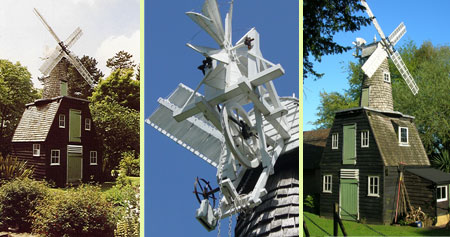Buckland Windmill: It’s History and Restoration

Open Days
Duncan and Bridget Ferns hold occasional Open Days and at other times the windmill may be opened by appointment – please phone 07786 966841 before visiting or email Duncan Ferns.
Yewdells & the Sawyer’s business
The windmill is in the garden of ‘Yewdells’, a Grade II listed house built in 1713 for John Udall—from which the house name is derived. John Udall was a carpenter who trained apprentices. Three generations of Udalls managed the business before it passed to the Sanders family around 1840. From 1840 through to the 1950’s, five generations of the Sanders family ran a sawyers business from the site. Records confirm that the Sanders purchased a stationary steam engine and saw in 1892, followed by a Wantage Traction Engine in 1900, purchased for £475 (see Buckland Windmill’s Steam Engines page)
The Windmill
The windmill is most likely to have been built in the 1860-1870 period. This build date is confirmed by the plaque detailing ‘W Cooper of Henfield’ who operated as a millwright from 1854-1876. We can assume that the windmill was disused by 1892 (when the more efficient steam engine was purchased to saw the wood), so if the windmill ever worked, it would have been for a very short period.
Standing on a shallow brick foundation, the mill is a 3 x 3 metre, two storey structure with a flat lead roof, from which rises a tapered round tower to a height of 3 metres.
The overall height to the top of the sails is just 12 metres, tiny in comparison with more typical corn grinding mills. Wooden ladder staircases rise to the first floor and the doors in the turret which give access to the flat lead roof. Maintenance is carried out from the flat roof. One of the two chains is for opening & closing the shutters on the sails, and the second for winding the cap to an accessible position for fantail maintenance. The rope releases the brake on the sails.
Does it work?
Yes … the windmill was designed to be practical—it is not an ’aesthetic folly’. The saw and lathe work from belts driven by the lineshaft, which is driven either directly from the sails or by an electric motor—though usually at too low a speed to be commercially practicable.
Around 15-20 similar small wind-powered sawmills have been recorded across England, though they were never as common as corn mills due to their inefficiencies. All except Buckland have been demolished, leaving Buckland Windmill as the only surviving wind-powered sawmill in the UK.
The windmill was rediscovered by the new owners of Yewdells in 1995. It had previously escaped the notice of windmill experts due to it being hidden from public view and in a derelict condition. Many components, including the shuttered sails were found stored inside the windmill.
The restoration took place from 1995 to 2004, in three distinct phases under the management of the owner. Around 25% of costs were reimbursed from grants from the Defra Rural Enterprise Scheme, Surrey Historic Buildings Trust, BAA and Mole Valley DC.
Cleft oak shingles cover the turret and roof, and the weatherboards are coated with coal tar. The fantail now turns the cap into the wind and the sails turn in the wind on release of the brake. The restoration work resulted in two awards in 2003-04, from Surrey Industrial History Group & Surrey Historic Buildings Trust:
Further Resources
Buckland Windmill’s Steam Engines





